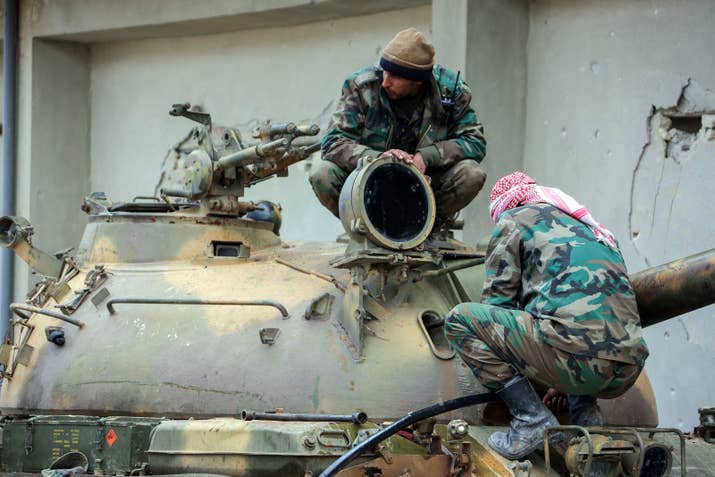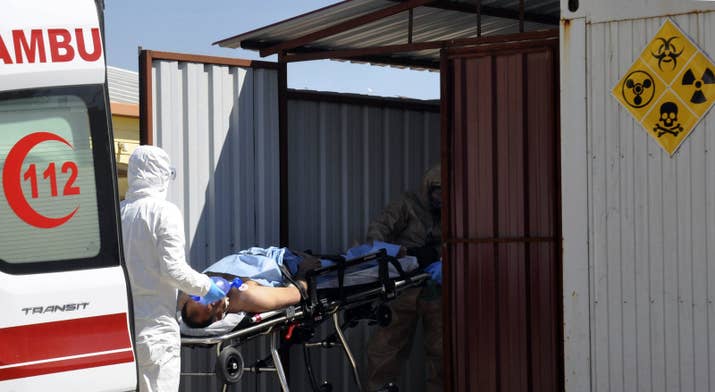
'The Trump administration seems confident that a US warning Monday headed off a planned chemical attack by forces loyal to Syrian President Bashar al-Assad, but is divided over which part of Syria the government actually planned to attack.
Some intelligence officials, particularly in the US military, believe that the regime, whose troops in recent weeks have been pushing eastward, had its sights set on Deir Ezzor, an ISIS-controlled city near the Iraqi border where thousands of Syrian army troops are surrounded. Others believe the target was likely remaining pockets of opposition in the west, around the cities of Homs and Hama or in the suburbs of the capital, Damascus.
The officials said Assad might consider either to be strategically important enough to risk the international fallout from using chemical weapons, which have been banned internationally for nearly a century. That said, it’s unknown whether US intelligence officials attempted to answer which target was most likely before the White House warned the Assad regime that it would “pay a heavy price” should it launch another chemical attack on civilians. Another possible target would be Idlib province, where some of the regime's most entrenched opposition sits.
US officials could not say for certain that the regime was planning such an attack. Instead, they said the warning was based on aircraft movements and “chatter” about a possible aerial attack to be launched from Shayrat airfield, the base from which a sarin gas attack was launched in April that killed more than 70 in the town of Khan Shaykhun, prompting the US to launch 59 Tomahawk missiles at the airfield two days later.
Some intelligence officials, particularly in the US military, believe that the regime, whose troops in recent weeks have been pushing eastward, had its sights set on Deir Ezzor, an ISIS-controlled city near the Iraqi border where thousands of Syrian army troops are surrounded. Others believe the target was likely remaining pockets of opposition in the west, around the cities of Homs and Hama or in the suburbs of the capital, Damascus.
The officials said Assad might consider either to be strategically important enough to risk the international fallout from using chemical weapons, which have been banned internationally for nearly a century. That said, it’s unknown whether US intelligence officials attempted to answer which target was most likely before the White House warned the Assad regime that it would “pay a heavy price” should it launch another chemical attack on civilians. Another possible target would be Idlib province, where some of the regime's most entrenched opposition sits.
US officials could not say for certain that the regime was planning such an attack. Instead, they said the warning was based on aircraft movements and “chatter” about a possible aerial attack to be launched from Shayrat airfield, the base from which a sarin gas attack was launched in April that killed more than 70 in the town of Khan Shaykhun, prompting the US to launch 59 Tomahawk missiles at the airfield two days later.
At first glance, it might seem hard to understand why the Assad regime would risk using chemical weapons. The strike on Shayrat airfield destroyed 20% of Syria’s operable aircraft, according to the US military, and the use of chemical weapons during the civil war has earned the Syrian government the moral denunciation of the world, particularly for the 2013 chemical attack in the Damascus suburbs that killed hundreds.
But despite government advances in recent months, the opposition continues to hold on to key territory after six years of brutal war, leaving the government to resort to chemical weapons in hopes of driving rebels from the areas they hold, according to Andrew Tabler, a Syria expert for the Washington Institute for Near East Policy.
Few weapons are as psychologically traumatizing as chemicals, Tabler said, and that, too, can be an incentive for the regime.
The Syrian government has most often used sarin gas to try to squash its opponents when its forces seem on the brink of a major loss. That was the case in 2013 when the regime faced stiff opposition in Damascus’s Ghouta suburbs. In April’s Khan Shaykhun attack, the target appeared to be a key opposition logistics hub far beyond the front lines.
But despite government advances in recent months, the opposition continues to hold on to key territory after six years of brutal war, leaving the government to resort to chemical weapons in hopes of driving rebels from the areas they hold, according to Andrew Tabler, a Syria expert for the Washington Institute for Near East Policy.
Few weapons are as psychologically traumatizing as chemicals, Tabler said, and that, too, can be an incentive for the regime.
The Syrian government has most often used sarin gas to try to squash its opponents when its forces seem on the brink of a major loss. That was the case in 2013 when the regime faced stiff opposition in Damascus’s Ghouta suburbs. In April’s Khan Shaykhun attack, the target appeared to be a key opposition logistics hub far beyond the front lines.
But why use chemical weapons now, and risk another Trump administration retaliation, particularly on areas already under unrelenting Russian aerial assault? As recently as Wednesday, warplanes attacked opposition and ISIS-controlled territory near Homs and Hama, according to the Syrian Observatory for Human Rights.
At the Pentagon, some officials believe pro-Assad forces may have intended to use chemicals to help break the siege at Deir Ezzor, where ISIS forces have surrounded a pocket of regime supporters.
“The regime is desperately trying to push out east to show they are sovereign over their country, which they haven’t been able to say in about half a decade,” Tabler said. “It’s completely logical they would use chemical weapons against ISIS because they think no one would care.”
There would be some precedent for such a move. Assad conducted a suspected sarin gas attack against an ISIS position east of Hama City in the months before the strike against Khan Shaykhun, and received basically no international backlash, said Jennifer Cafarella, a Syria analyst for the Washington Institute for the Study of War.
“It is possible he's preparing to test whether he can achieve the same outcome even post Shayrat strike,” Cafarella said.
At the Pentagon, some officials believe pro-Assad forces may have intended to use chemicals to help break the siege at Deir Ezzor, where ISIS forces have surrounded a pocket of regime supporters.
“The regime is desperately trying to push out east to show they are sovereign over their country, which they haven’t been able to say in about half a decade,” Tabler said. “It’s completely logical they would use chemical weapons against ISIS because they think no one would care.”
There would be some precedent for such a move. Assad conducted a suspected sarin gas attack against an ISIS position east of Hama City in the months before the strike against Khan Shaykhun, and received basically no international backlash, said Jennifer Cafarella, a Syria analyst for the Washington Institute for the Study of War.
“It is possible he's preparing to test whether he can achieve the same outcome even post Shayrat strike,” Cafarella said.
For the US military, the use of chemical weapons in the east be would particularly problematic as it would be in vicinity of US troops and bring the Syrian civil war physically closer to the ongoing US war against ISIS.
Other intelligence officials say the Damascus suburbs were the more likely target. Such an attack would be more in line with previous sarin gas attacks and would be designed to deal a death blow to opposition forces, a US official told BuzzFeed News.
“The full capture of the Syrian capital is a strategic objective for Assad. He is close to achieving it, but the remaining rebel holdout in eastern Ghouta will be difficult to capture,” Cafarella said. “One major chemical weapons attack could be decisive because it could provide enough disruption of the rebel-held area to enable pro-regime forces to break through final rebel defensive lines and seize the area.”
Other intelligence officials say the Damascus suburbs were the more likely target. Such an attack would be more in line with previous sarin gas attacks and would be designed to deal a death blow to opposition forces, a US official told BuzzFeed News.
“The full capture of the Syrian capital is a strategic objective for Assad. He is close to achieving it, but the remaining rebel holdout in eastern Ghouta will be difficult to capture,” Cafarella said. “One major chemical weapons attack could be decisive because it could provide enough disruption of the rebel-held area to enable pro-regime forces to break through final rebel defensive lines and seize the area.”
On Wednesday, Secretary of Defense Jim Mattis told reporters en route to Brussels that the preemptive statement Monday appeared to have worked.
“They took the warning seriously,” Mattis said. “They didn’t do it.”
But Tabler warned that the situation in Syria has not changed enough for the regime to rule out using sarin gas in the future.
“What drives all this is the regime does not have manpower to retake its territory,” he said.'
“They took the warning seriously,” Mattis said. “They didn’t do it.”
But Tabler warned that the situation in Syria has not changed enough for the regime to rule out using sarin gas in the future.
“What drives all this is the regime does not have manpower to retake its territory,” he said.'

No comments:
Post a Comment